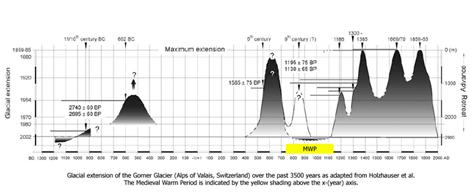Reference
Holzhauser, H., Magny, M. and Zumbuhl, H.J. 2005. Glacier and lake-level variations in west-central Europe over the last 3500 years. The Holocene 15: 789-801.
Description
Holzhauser et al. present a high-resolution record of glacial variation for Gorner glacier, in the Alps of Valis, Switzerland (~46.05°N, 7.62°E), as part of an effort to develop a 3500-year climate history of west-central Europe. In their estimation, "at no other glacier in the Swiss Alps ... [is] the Mediaeval Climatic Optimum so well documented as at the Gorner glacier," especially when the glacier retreated to levels beyond that of the present-day between AD 800 and 1100. Because glaciers in mountain areas are "highly sensitive to climate changes and thus provide one of nature's clearest signals of warming or cooling and/or dry and wet climate periods," as they describe it, "one can say that the quasi periodical fluctuations of Alpine glaciers were driven by glacier-hostile (warm/dry) and glacier-friendly (cool/wet) periods." On this basis, therefore, one can cautiously conclude that temperatures at Gorner Glacier were likely warmer during the Medieval Warm Period than they have been recently.





